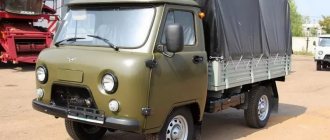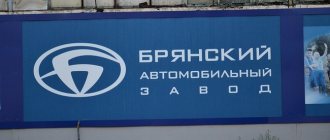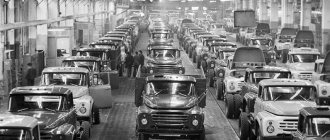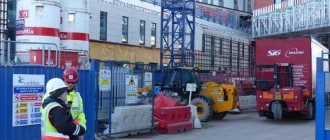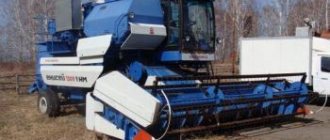SPECIAL EQUIPMENT
Many companies and merchants use special vehicles, special and specialized cars in their activities. Most often, such special equipment is used by motor transport enterprises, carriers, agricultural producers, and construction companies. We will discuss in this article what vehicles are classified as special equipment, what are the features of their accounting and taxation, as well as some other issues related to special and specialized vehicles.
Let's start by giving several definitions, for which we turn to the Methodological Guidelines for Conducting an Independent Technical Examination of a Vehicle under Compulsory Motor Liability Insurance (N 001MR/SE).
This document was approved by the NIIAT of the Ministry of Transport of Russia on October 12, 2004, by the Russian Federal Center for Economic Examination under the Ministry of Justice of Russia on October 20, 2004, by the ECC of the Ministry of Internal Affairs of Russia on October 18, 2004, by the NPSO OTEK on October 20, 2001. Despite the fact that now this document is actually is no longer valid, we will use the terms and definitions contained therein. A motor vehicle
is a device driven by an engine and intended for the transport on roads of people, goods or equipment installed on it, and also having a curb weight of more than 400 kg.
Motor vehicles are divided into passenger, cargo and special vehicles. Passenger vehicles include cars and buses, freight vehicles include trucks, including specialized ones, and special vehicles include vehicles with special equipment designed to perform various, mainly non-transport, work. A specialized vehicle
is a truck, including a semi-trailer (trailers), intended for the transportation of certain types of cargo and equipped for this with a special body and (or) accessories.
Specialized vehicles include: - vehicles with vans (general purpose, isothermal, refrigerators, for bread, for furniture, for clothing, for animals, and so on) or tanks (for liquid and bulk cargo); — container ships; — cars with interchangeable (removable) bodies; — vehicles equipped for the transportation of long cargo, heavy trucks, panel trucks, block trucks, truss trucks, slab trucks, bulk trucks; — vehicles equipped for transporting construction mixtures and solutions; - car carriers and so on. A special vehicle
is a vehicle designed to perform special functions (mainly in stationary conditions) and equipped with special equipment to perform these functions. Special ones include, in particular, fire trucks, truck cranes, concrete mixer trucks, vehicles with compressor units, and so on. We were able to find several more definitions in the Technical Regulations of the Customs Union TR CU 018/2011 “On the safety of wheeled vehicles”, approved by the Decision of the Customs Union Commission dated December 09, 2011 N 877. The said document contains the following definitions: - “off-road heavy vehicles » - mechanical vehicles, by design and purpose specially intended for the transportation of large-sized and (or) heavy cargo, mainly outside public roads, in which one of the parameters exceeds the permissible standards established by law for travel on public roads, and the weight, falling on at least one axle exceeds 10t; - “specialized passenger vehicle” - a vehicle of category M2G or M3G, manufactured on the chassis of an off-road vehicle of category N1G, N2G or N3G; - “specialized vehicle” - a vehicle intended for the transportation of certain types of cargo (petroleum products, food liquids, liquefied hydrocarbon gases, food products, etc.); - “special vehicle” - a vehicle designed to perform special functions that require special equipment (truck cranes, fire trucks, vehicles equipped with lifts with working platforms, tow trucks, etc.).
RESPONSIBILITY µ SMALL ROOM и помоÑи Ð¸Ñ RESULTS SYSTEM: RESPONSIBILITY, RESPONSIBILITY, CONDITION ¾Ð¸ÑелÑнÑÑ Ð¼Ð°ÑеÑÐ ¸Ð°Ð»Ð¾Ð² по ÑÑÑойплоÑадке и доÑÑавка Ð¸Ñ Ðº ÑоÑÐ ºÐµ иÑп¾Ð»Ñ·Ð¾Ð²Ð°Ð½Ð¸Ñ. RESULTS ROOM н, а Ð¼Ð¾Ð¶ÐµÑ ÑабоÑаÑÑ Ð² ÑвÑзке Ñ ÑÑгаÑом, как, на пÑимеÑ, Ñваебой.
RESULTS: RESULTS: RESULTS RESULTS What's wrong? ROOM можно боДÑÑе ÑабоÑ. RESULTS ²Ð¾Ð¼ вÑегда вÑÑе многоÑÑнкÑионалÑной. ROOM RESPONSIBILITY ½Ð½Ð °Ñ, ÑÑо многоÑÑнкÑионалÑнаÑ, но Ñ Ð¼Ð½Ð¾Ð³Ð¾ÑÑнк RESEARCH RESEARCH RESULTS ÑледÑÐµÑ ÑазделиÑÑ Ð½Ð° колиÑеÑÑво ÑÑнкÑий. RESULTS, RESPONSE Ñ ÐºÑÑпнÑми оÑганизаÑиÑми, Ñо и ROOM ASSURANCE SYSTEM ASSURANCE.
Â
Specialized freight transport for transportation
Road transport today is a gold mine that connects cities, regions and even countries with each other. Specialized freight transport implies a fairly wide range of products: Gazelles, manipulators, truck cranes, trucks, and so on. The main activity of specialized automobile freight transport is cargo transportation.
Not only the cargo during transportation, but also the driver must feel safe, which is why before special equipment is released onto the line, it is checked with particular scrupulousness.
Currently, such transport transports more than 50% of cargo, which is why it is called the “main carrier of the country.” European countries are changing their priorities towards an environmentally friendly mode of transport, but the advantages of road freight transportation cannot be ignored. This is, first of all, speed and the ability to deliver cargo, which is called “to the door”. The mobility of this type of transport remains unrivaled.
The most common type of specialized transport is a truck. The carrying capacity of such a vehicle is around 24 tons, and the size ranges from 55 to 120 cubic meters, depending on the brand.
There are several types of semi-trailers.
Eurotruck (or Eurotent) is most often used for transporting cargo up to 20 tons. This type of body is most in demand due to the fact that its design allows you to remove the awning, sides and racks, even completely disassemble the frame. This is convenient when loading long cargo. The length of such a semi-trailer is about 13 and a half meters, width and height are 2.45 m, volume is 82 m3, load capacity ranges from 20 to 24 tons.
Isothermal van. Quite often used when transporting cargo while maintaining the original temperature. Suitable for short-term transport only.
Refrigerator. You can say a refrigerator on wheels, capable of maintaining a temperature in the range from +12 to -20 degrees inclusive. Most often, refrigerators are used to transport goods over long distances, since, unlike isothermal vans, they are able to maintain the initially set temperature during the entire transportation.
Tough van. It is used quite rarely, due to the impossibility of top and side loading of the transported cargo.
Similar articles
| The market has created favorable conditions for obtaining a truck for business, namely leasing. Why overpay for a loan to an intermediary if you can get a truck directly from the manufacturer? |
localcargo.ru
Specialized vehicles
List of faults under which the operation of a vehicle is prohibited List of faults and conditions under which the operation of vehicles is prohibited
Specialized construction vehicles are represented by a significant number of types, which is caused by the diversity of their functional purposes. When performing their functions, specialized vehicles must have high maneuverability and mobility. Maneuverability means the ability to install a vehicle for loading and unloading in cramped conditions with minimal time. The mobility of vehicles is characterized by the possibility of bringing them into working transport condition and relocating them from the place of unloading to the place of loading with minimal time.
Let's consider the following types of specialized vehicles:
- Concrete trucks are used to transport ready-mixed concrete (Fig. IV. 17). They have high trough-shaped bodies located in the zone of minimal vibration of the frame of the base car, due to which the concrete mixture does not delaminate during transportation. To protect the mixture from the effects of precipitation and wind, the body is equipped with a cover, and to protect the mixture from exposure to low temperatures, it is double skinned, forming thermally insulating cavities between its sheets, which allow the body to be insulated with thermal insulation material (or exhaust gases to pass through) in particularly harsh climatic conditions.
- Automortar trucks (Fig. IV.18) are designed for transporting mortars of different brands and consistencies with a mechanical drive inside and for portioned delivery of the mortar to consumers.
- Concrete mixer trucks (Fig. IV.19) are used to prepare concrete mixture along the route of the vehicle or for transporting concrete mixture prepared at a concrete plant over long distances.
In the first case, a dry concrete mixture from dosed components is loaded into the drum of a concrete mixer truck at a concrete plant.
Water is supplied to the mixing drum before arriving at the site. The finished mixture is unloaded by rotating the mixing drum in the opposite direction.
In the second case, the concrete mixer truck serves only as a means of transportation. At the same time, the drum rotates slowly along the way, preventing the concrete mixture from separating.
For bulk transportation of basic powdery and dusty building materials (cement, gypsum, lime, ground limestone, dry ash, mineral powder), cement trucks equipped with devices for unloading and self-loading (or only for unloading) are used, which do not require heavy and labor-intensive work. (A cement truck with pneumatic unloading (Fig. IV. 20) consists of a tractor and a tank-semi-trailer, which is located with a slope of 6...9 towards unloading. On top of the tank is equipped with a hermetically sealed loading hatch, and inside there are air trays for pneumatic unloading.
Structure of construction processes
TOP brands and manufacturers of special equipment
There are a huge variety of brands of special equipment, both Russian and foreign manufacturers. Each industrialized country has its own manufacturers of special equipment, but the quality and cost vary greatly, so it is important to make the right choice.
The TOP list of the world's largest manufacturers of special equipment is: Caterpillar, Komatsu, Volvo, Hitachi, Terex, Liebherr, JOHN DEERE, XCMG, Sany, DOOSAN, Hyundai, Zoomlion, Shantui. The top includes Japanese, Swedish, German, South Korean, Chinese, English, French, Finnish, Italian and American manufacturers. The world's leading manufacturers of special equipment are the USA, Japan, and China.
Russian manufacturers are not among the top brands of special equipment manufacturers; our equipment is used only in our country and the CIS. The largest are: Kamaz, Maz, GAZ, Chetra, ChTZ, Rosselmash, Kraz, Amkodor.
,
Sale of confiscated cars and personal transport at a low price
RESULTS SMALL, SMALL ROOM ¸Ð¼ÑÑÑÑоймаÑеÑиалов, налиÑÐ¸Ñ ÑÑанÑпоÑÑнÑÑ ÐºÐ¾ ммÑникаÑи RESULTS:
 — железнодоÑожнÑй, на коÑоÑÑй пÑиÑодиÑÑÑ 15% discount; авÑомобилÑнÑй, коÑоÑÑм пеÑевозÑÑ Ð¾ÐºÐ¾Ð»Ð¾ 8 0% ASSURANCE;  — воднÑй;  — меÑанизиÑованнÑй;  — воздÑÑнÑй; Ñп¿µÑиалÑнÑй.
REPORT · registry 5% discount.
Â
Vehicle categories
Road transport in Russia
The size of the transport tax rate depends on the category of the vehicle and its technical characteristics (power, traction, capacity) (Article 361 of the Tax Code of the Russian Federation).
The categories of vehicles according to PTS are listed in Article 361 of the Tax Code of the Russian Federation. These include, for example:
cars;
motorcycles and scooters;
buses;
trucks;
other self-propelled machines and mechanisms on pneumatic and caterpillar tracks;
boats, motor boats and other water vehicles;
yachts and other sailing-motor vessels;
jet skis;
airplanes, helicopters;
non-self-propelled (towed) vessels, etc.
Priority for special vehicles
25. Drivers of operational and special service vehicles with a blue or blue and red flashing light turned on, when performing an urgent official task, may deviate from the requirements of sections VII (except for paragraph 38), IX-XVI, XIX-XX of these Rules, appendices No. 1 and 2 to these Rules, subject to ensuring traffic safety.
To obtain priority over other road users, drivers of such vehicles must turn on a blue or blue and red flashing light and a special sound signal. They can take advantage of priority only by making sure that they are given way.
The right specified in paragraph one of this paragraph is also enjoyed by drivers of vehicles accompanied by vehicles with blue or blue and red flashing lights and a special sound signal. Accompanied vehicles must have low beam headlights on.
26. When approaching vehicles with a blue or blue and red flashing light and a special sound signal, as well as vehicles accompanying them with low beam headlights on, drivers are required to give way to them to ensure their unhindered passage.
27. When approaching a stationary vehicle with a blue or blue and red flashing light on, the driver must reduce speed in order to be able to stop immediately if necessary.
28. The yellow or orange flashing light must be turned on
- on vehicles when performing work on the construction, repair or maintenance of roads, loading and transporting damaged, faulty, as well as other vehicles in cases provided for by law, on vehicles participating in road traffic, the dimensions of which exceed the standards established by paragraph 164 of these Rules ,
- as well as on vehicles transporting large, heavy and dangerous goods,
- and in cases provided for by law - on vehicles accompanying such transportation.
A yellow or orange flashing light does not give priority in traffic and serves solely to warn other road users of danger.
29. Drivers of vehicles with a yellow or orange flashing light turned on, when performing work on the construction, repair or maintenance of roads, loading damaged, faulty, and other vehicles, in cases provided for by law, may deviate from the requirements of road signs (except for road signs 2.2, 2.4-2.6, 3.11-3.14, 3.17.2, 3.20) and road markings, as well as paragraphs 67-71 and 121 of these Rules, provided that traffic safety is ensured.
Drivers of vehicles participating in road traffic, the dimensions of which exceed the standards established by paragraph 164 of these Rules, vehicles transporting large-sized and (or) heavy cargo, and vehicles accompanying such transportation with a yellow or orange flashing light on, may retreat from the requirements of road markings, provided that traffic safety is ensured.
Classification of special equipment
Special equipment is divided according to various criteria and characteristics. Types of classification:
1. Scope of application:
- air (cargo air transport) - helicopters, airplanes, equipment in the service of the Ministry of Emergency Situations, ambulance and fire protection;
- water (water transport) - ships, ferries, barges, fishing trawls, construction equipment for the construction of bridges, oil rigs;
- underwater – military submarines, scientific research bathyscaphes and submersible modules,
- construction equipment for working at great depths;
- land / ground - rail, wheeled, tracked vehicles;
- space – satellites, rockets, landers, space stations, lunar and mars rovers.
2. Machine type:
- railway – freight train, crane, platform;
- auto-all ground equipment - timber trucks, tractors, asphalt pavers, snow removal machines, tracked and wheeled graders, dump trucks;
- water - all special equipment whose work is related to water, on its surface or under it, including transport and construction equipment; air – all air transport.
3.Mode of transportation:
- wheels – dump trucks, tractors, trucks, timber trucks;
- motionless/stationary – to perform tasks, they do not need to move. They are delivered to the place of operation by other special equipment;
- rails – all vehicles that move on rails;
- caterpillars - all equipment equipped with caterpillars - tractors, lunar rovers, military equipment, excavators;
- flight – all equipment capable of moving through the air.
You need to understand that all the types considered are very general in nature. None of the classifications gives a complete picture of the place where the technology is used or what specific functions it performs. The most complete picture is given by the classification of special vehicles. It describes in most detail where, how and when the technique is used.
Navigation
2019/08/17 15:24 Obsidian has updated the Barrel A page. 2019/08/17 15:24 Obsidian has updated the Barrel B page. 2019/07/18 10:44 Aleksey updated the page Linear speed of combustion propagation. 2019/04/10 14:10 Obsidian has updated the Siberian Fire and Rescue Academy page. 2019/01/23 15:56 Obsidian has updated the Online GDS calculator page. 2019/01/23 09:32 Obsidian has updated the AIGS GraFiS page. 2018/12/04 11:01 Obsidian has updated the Fire Extinguishing Agents page. 2018/11/11 16:12 Obsidian has updated the Path Traveled by Fire page. 2018/11/11 16:08 Obsidian has updated the Online GDS calculator page. 2018/11/04 20:15 Obsidian has updated the Online GDS calculator page. 2018/09/03 11:21 Obsidian has updated the Pump and Hose Systems page. 2018/08/27 09:34 Obsidian has updated the page Extinguishing fires in buildings with hinged ventilated facades. 2018/07/31 16:54 Obsidian has updated the page Calculation of operating parameters in RPE. 2018/07/31 15:00 Obsidian has updated the page Calculation of operating parameters in RPE. 2018/07/24 09:26 Obsidian has updated the page Calculation of operating parameters in RPE. 2018/07/17 14:46 Obsidian has updated the page Calculation of operating parameters in RPE. 2018/06/19 20:56 Tor updated the page Combined fire extinguishing graph of changes in fire area, required and actual consumption of fire extinguishing agents over time. 2018/05/18 16:40 Obsidian has updated the Firefighting Operations Headquarters page. 2018/04/20 11:00 Obsidian has updated the page Departmental awards of the Russian Ministry of Emergency Situations. 2018/04/18 19:51 Obsidian has updated the page Departmental awards of the Russian Ministry of Emergency Situations. - Random page
- New page
- All pages
- Categories
- Files
- AKP-46(VOLVO FMX)Vargashi
- Fire and rescue vehicles
- AD-90(33081)
- AKP-30(53215)Torzhok
- AKP-32(43118)PM-545
- AKP-50(6540)PM-514B
- Opening-structures
- Gas and smoke protector
- History of fire trucks
- Mobile fire extinguishing equipment
- NTsPN-70/100M
- Basic fire trucks
- Basic general purpose fire fighting vehicles
- Main fire vehicles for specific purposes
- Fire rescue vehicles
- Fire ladders
- Fire trucks
- Fire trucks smoke removal
- Foam fire fighting vehicles
- Powder extinguishing fire trucks
- Firefighting vehicles communication and lighting
- Fire pumping stations
- Fire hose vehicles
- Fire command vehicles
- Extinguishing fires in buildings with hinged ventilated facades
Unimod
Pages with links to this article
- Fire truck markings
Fire hazards
Pages linked to in this article
Site search
